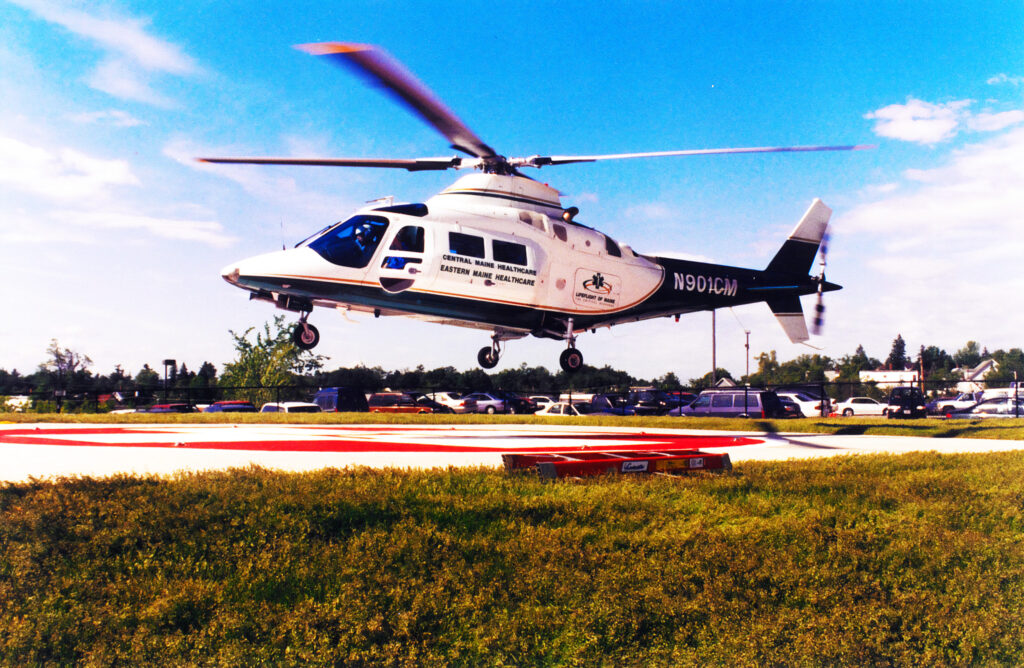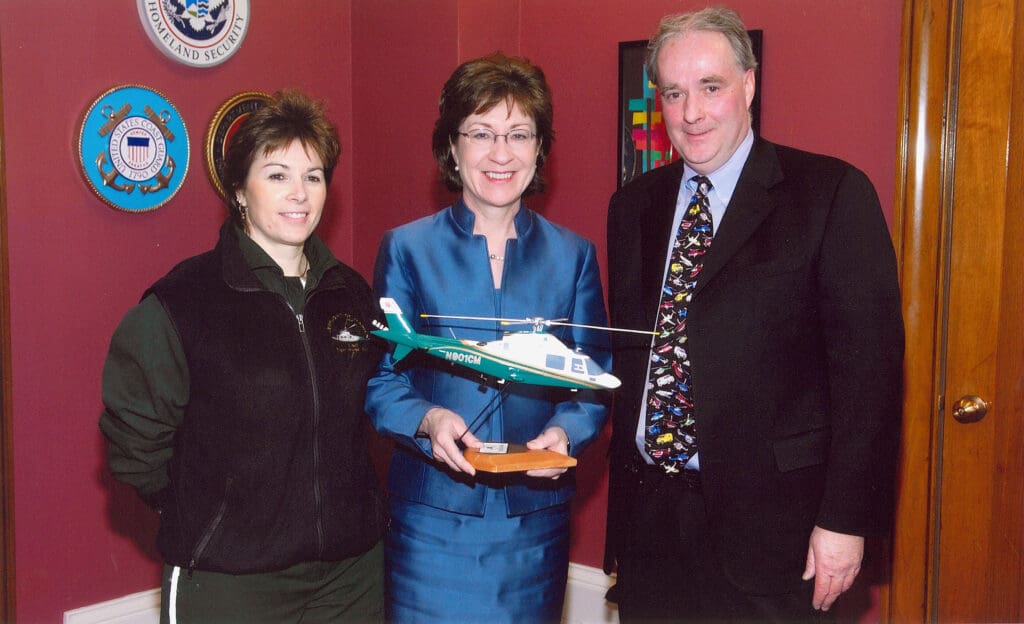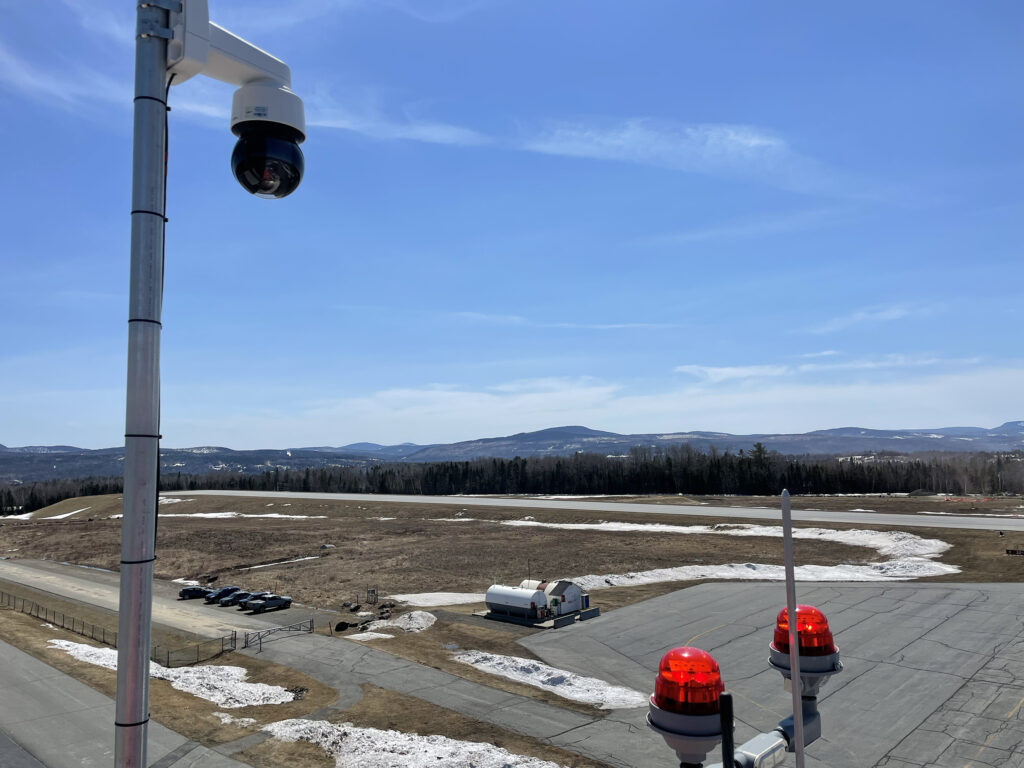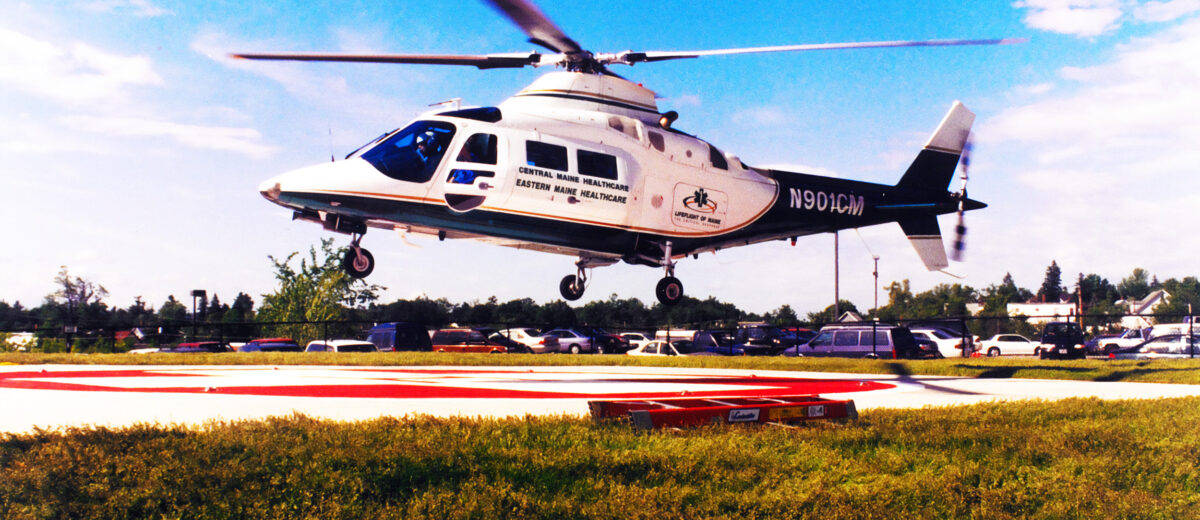Public Investment in Critical Care
Significant public investment in medical and aviation infrastructure across Maine has made LifeFlight safer and more reliable.

by Henry Frank
This article appeared in the October 2023 issue of Dispatches.
A veteran LifeFlight of Maine pilot describes a helicopter as “a machine that’s got 10,000 parts in formation desperately trying to depart from each other.” When all those parts are rotating together, that machine crosses the Maine skies at 175 miles per hour with three crew on board delivering lifesaving, ICU-level care in its cramped fuselage.
As a nonprofit organization, LifeFlight of Maine functions similarly. Its impact is greater than the sum of its parts, but each of those parts is vitally important. The dispatcher sits at a desk in the communications center and answers a phone call in the middle of the night from an ER doctor or a firefighter on scene. The pilot reviews weather data from AWOS stations (automated weather observing system) along the flightpath to assure the safety of flight and files a flight plan. The nurse and paramedic grab their equipment, medications, and units of blood as they all do a quick risk assessment and take off to meet the patient at the point of need.
Before the aircraft even lifts off the ground, a team of highly-skilled aircraft maintenance technicians has ensured the machine is safe to fly. Once airborne, the pilot relies on radio repeater sites on mountaintops to stay in communication. And of course, the aircraft needs to land safely, so it follows Federal Aviation Administration (FAA) certified approach procedures to a designated helipad or emergency landing zone on one of Maine’s islands.
None of this existed in Maine when LifeFlight was founded in 1998. It had to be built from scratch, and funds needed to be raised. To this nonprofit and the state’s only air ambulance service, the people of Maine are as integral as the engines that make the helicopter rotors whirl — without them, none of this would be possible.
The investment in LifeFlight over the years by the people of Maine is monumental. The LifeFlight Foundation has raised more than $41 million to date. Millions of dollars in individual donations have allowed LifeFlight to purchase state-of-the-art aircraft and medical technology — including isolettes for transporting infants, heart monitors, infusion pumps, ventilators, ultrasounds, and specialty resuscitation equipment.

Of the funds raised by the Foundation, public funding supports aviation infrastructure. In addition to private philanthropy, the people of Maine have contributed more than $6 million in public dollars through the state legislature. Three bonds were passed that included funding for LifeFlight — the first in 2003, the second in 2009, and the third in 2012. There were two helipads in Maine in 1998. Today, 32 Maine hospitals have helipads. The bonds supported their construction, along with other improvements in Maine’s aviation infrastructure, including the installation of 18 AWOS stations, fuel trucks, and communication towers. The funds were also used to purchase patient simulators, which help train LifeFlight and other EMS crews. In addition to the legislature initiated bonds, the US Department of Agriculture (USDA) and the Maine Emergency Management Agency (MEMA) have both made grants to support LifeFlight infrastructure.
Bonds represent public investments in public goods. “The public has made a huge investment in infrastructure to make sure that LifeFlight can serve patients,” said Tom Judge, founder and executive director of LifeFlight of Maine. “This makes our service safer and more reliable for patients.” It also has made air travel in Maine safer in general, as any aviator can utilize this infrastructure. The National Weather Service, farmers, and the fishing community also rely on these weather systems LifeFlight has placed around the state.
“We got tremendous support for building helipads in rural areas and on the islands. I think the public understood that without this helicopter service they were in trouble. They got it, and they understood that this was important for their communities.”
– Peter Chalke, former CEO of Central Maine Healthcare
In addition to statewide bonds, 265 municipalities in Maine together have contributed more than $800,000 to LifeFlight through the Foundation’s Community Giving Program. In 25 years, LifeFlight has transported a resident of every single community in Maine. From the islands to the mountains and everywhere in between, Maine communities understand the vital role LifeFlight plays, and they continue to invest year after year. Their support helps ensure that the aircraft are as advanced, safe, and fast as possible, and that the medical equipment on board is the best available. LifeFlight truly is “of Maine” in every sense.
Millions of federal dollars have also poured into Maine with LifeFlight’s help and at the behest of Maine communities. Anyone landing a plane at Stephen A. Bean Municipal Airport in Rangeley has the benefit of all 4,301 feet of runway. The airport’s website states: “In 2018, the Town of Rangeley was awarded an $11.5 million grant to expand the runway for emergency medical services. The award was through the Federal Aviation Administration’s Airport Improvement Program. The 3,201-foot runway was too short to accommodate LifeFlight of Maine’s King Air B200 plane.” With its expertise and close ties to the FAA, LifeFlight was an instrumental partner to Rangeley in acquiring this grant. Similar projects have been undertaken by the towns of Jackman and Eastport also with funding from those communities, the Maine Department of Transportation, and the FAA.
An investment in aviation infrastructure in Maine is an investment in healthcare. Maine is the most rural state in the country, according to the US Census Bureau, with weather and geography that is as varied as just about anywhere. When a call comes in, the LifeFlight pilot is given only the location and weight of the patient. This is to ensure that the decision to accept the call is entirely based on safety. Can the aircraft safely fly to pick up the patient, can it safely deliver the patient to the receiving hospital, and can it safely return to base? If all three of these questions cannot be answered affirmatively, then LifeFlight is unable to transport the patient.

Every call LifeFlight receives is an emergency. If pilots are uncertain about weather conditions, they will err on the side of caution and remain on the ground. But if their weather data is up-to-the- minute, and if they can see a live feed of the helipad they are flying to, the guesswork recedes.
With funding from MEMA, LifeFlight is installing weather cameras on 35 runways and helipads across Maine. These cameras let the pilots see the current weather conditions and, along with data from AWOS stations, give them a better picture, allowing them to accept calls they would otherwise decline for safety if the weather is unknown. As a result, LifeFlight is able to get more patients to the care they need and make more second chances possible.
LifeFlight’s expert aviation team is also working with the FAA to develop precision IFR routes (instrument flight rules) across Maine and SIAPs (special instrument approach procedures), which typically cost tens of thousands of dollars each year to maintain. The FAA, with LifeFlight’s assistance, maintains these at no cost to LifeFlight or to the State of Maine. When flying highly advanced aircraft like LifeFight’s AW109 SP helicopters — which LifeFlight was able to acquire through generous private philanthropic support — these IFR routes and SIAPs allow the aircraft to fly safely through clouds and in more weather conditions. With the ocean to the east and mountains to the west and north, such conditions are simply a fact of life in Maine.
Twenty-five years ago, LifeFlight made a promise to the people of Maine that it would be there for them, when and where needed. The people of Maine continue to invest generously in helping LifeFlight keep that promise. Not-for-profit air medical service works when all the parts are working together, and the people of Maine are the most essential of those parts.
Thanks to generous public investment over the years, LifeFlight is one of the leading air medical providers nationwide and is revered by its peers globally. It is pioneering advances in emergency medicine and aviation infrastructure that one day will benefit every American. The people of Maine understand the importance of ensuring that everyone has access to the healthcare they need, whether they live on main street or down a logging road. As other states work to follow this example, Mainers can proudly say, “we did it first.”
Henry Frank is the director of communications for LifeFlight of Maine.

